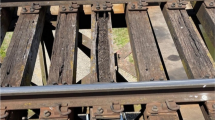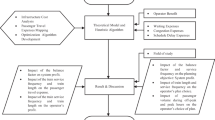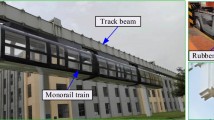Abstract
The prediction of wheel and rail wear is a fundamental issue in the railway field, both in terms of vehicle stability and in terms of economic costs (planning of maintenance interventions). In particular the need of an accurate wear model arises from the interest of Trenitalia S.p.A. and Rete Ferroviara Italiana in designing new wheel and rail profiles and new bogie architectures optimized from the wear viewpoint with the aim of improving the wear and stability behavior of the standard ORE S1002 wheel profile matched with the UIC60 rail profile canted at 1/20 rad (which represents the wheel–rail combination adopted by the Italian railway line). In this work the authors present a wear model specifically developed for the evaluation of the wheel and rail profile evolution, the layout of which is made up of two mutually interactive but separate units: a vehicle model for the dynamical analysis and a model for the wear evaluation. Subsequently the new model has been compared with the wear evaluation procedure implemented in Simpack, a widely tested and validated multibody software for the analysis of the railway vehicle dynamics; the comparison aims both to evaluate the model performance (in terms of accuracy and efficiency) and to further validate the wear model (just tested, as regards the wheel wear prediction, in previous works related to the critical Aosta–Pre Saint Didier line).
The comparison has been carried out considering a benchmark train composed by a locomotive (E.464) and a passenger vehicle (Vivalto) provided by Trenitalia while the simulations have been performed on a mean Italian railway line (obtained by means of a statistical analysis of the data relative to the whole Italian railway network provided by Rete Ferroviaria Italiana (RFI)).

























































Similar content being viewed by others
References
Krause, H., Poll, G.: Verschleißbei gleitender und wälzender Relativbewegung. Tribol. Schmier.tech. 31(4/5), 209–214/285–289 (1984)
Specht, W.: Beitrag zur rechnerischen Bestimmung des Rad- und Schienenverschleisses durch Gueterwagen Diss. RWTH Aachen (1985)
Pombo, J., Ambrosio, J., Pereira, M., Lewis, R., Dwyer-Joyce, R., Ariaudo, C., Kuka, N.: A study on wear evaluation of railway wheels based on multibody dynamics and wear computation. Multibody Syst. Dyn. 24, 347–366 (2010)
Jendel, T., Berg, M.: Prediction of wheel profile wear. Suppl. Veh. Syst. Dyn. 37, 502–513 (2002)
Zobory, I.: Prediction of wheel/rail profile wear. Veh. Syst. Dyn. 28, 221–259 (1997)
Ignesti, M., Malvezzi, M., Marini, L., Meli, E., Rindi, A.: Development of a wear model for the prediction of wheel and rail profile evolution in railway systems. Wear 284–285, 1–17 (2012)
Auciello, J., Ignesti, M., Malvezzi, M., Meli, E., Rindi, A.: Development and validation of a wear model for the analysis of the wheel profile evolution in railway vehicles. Veh. Syst. Dyn. 50(11), 1707–1734 (2012)
Braghin, F., Lewis, R., Dwyer-Joyce, R.S., Bruni, S.: A mathematical model to predict railway wheel profile evolution due to wear. Wear 261, 1253–1264 (2006)
Hardwick, C., Lewis, R., Eadie, D.: Wheel and rail wear—understanding the effect of third body materials. In: CM2012 9th International Conference on Contact Mechanics and Wear of Rail/Wheel Systems, Chengdu, China (2012)
Meli, E., Falomi, S., Malvezzi, M., Rindi, A.: Determination of wheel–rail contact points with semianalytic methods. Multibody Syst. Dyn. 271, 238–245 (2008)
Auciello, J., Meli, E., Falomi, S., Malvezzi, M.: Dynamic simulation of railway vehicles: wheel/rail contact analysis. Veh. Syst. Dyn. 47, 867–899 (2009)
Hertz, H.: The contact of elastic solids. J. Reine Angew. Math. 92, 156–171 (1881)
Kalker, J.J.: Three-Dimensional Elastic Bodies in Rolling Contact. Kluwer Academic, Dordrecht (1990)
Kalker, J.J.: Survey of wheel–rail rolling contact theory. Veh. Syst. Dyn. 8, 317–358 (1979)
Enblom, R., Berg, M.: Simulation of railway wheel profile development due to wear influence of disc braking and contact environment. Wear 258, 1055–1063 (2005)
Official site of Simpack GmbH (2012). http://www.simpack.com
Pombo, J., Ambrosio, J., Pereira, M., Lewis, R., Dwyer-Joyce, R., Ariaudo, C., Kuka, N.: Development of a wear prediction tool for steel railway wheels using three alternative wear functions. Wear 20, 327–358 (2011)
Toni, P.: Ottimizzazione dei profili delle ruote su binario con posa 1/20. Tech. rep., Trenitalia S.p.A. (2010)
Iwnicki, S.: The Manchester Benchmarks for Rail Vehicle Simulators. Swets and Zeitlinger, Lisse (1999)
Meli, E., Magheri, S., Malvezzi, M., Rindi, A.: An innovative wheel–rail contact model for multibody applications. Wear 271, 462–471 (2011)
Meli, E., Magheri, S., Malvezzi, M.: Development and implementation of a differential elastic wheel–rail contact model for multibody applications. Veh. Syst. Dyn. 49(6), 969–1001 (2011)
Johnson, K.: Contact Mechanics. Cambridge University Press, Cambridge (1985)
Shabana, A.A., Tobaa, M., Sugiyama, H., Zaazaa, K.E.: On the computer formulations of the wheel/rail contact problem. Nonlinear Dyn. 40, 169–193 (2005)
Iwnicki, S.: Simulation of wheel–rail contact forces. Fatigue Fract. Eng. Mater. Struct. 26, 887–900 (2003)
Kalker, J.J.: A fast algorithm for the simplified theory of rolling contact. Veh. Syst. Dyn. 11, 1–13 (1982)
EN 14363: Railway applications—Testing for the acceptance of running characteristics of railway vehicles—Testing of running behavior and stationary tests (2005)
EN 15313: Railway applications—In-service wheelset operation requirements—In-service and off-vehicle wheelset maintenance (2010)
Oppenheim, A., Schafer, R.W.: Discrete-Time Signal Processing. Prentice-Hall, Englewood Cliffs (1989)
Esveld, C.: Modern railway track. Delft University of Technology, Delft, Netherlands, 2001 (1985)
Acknowledgements
Authors would like to thank Engg. R. Cheli and G. Grande of Trenitalia S.p.A. for providing and giving the permission to edit the data relative to the vehicle composed by the E.464 locomotive and the Vivalto passenger coach; a special thanks also goes to the Engg. R. Mele and M. Finocchi of Rete Ferroviaria Italiana for the data relative to the whole Italian railway network.
Author information
Authors and Affiliations
Corresponding author
Rights and permissions
About this article
Cite this article
Ignesti, M., Innocenti, A., Marini, L. et al. Development of a model for the simultaneous analysis of wheel and rail wear in railway systems. Multibody Syst Dyn 31, 191–240 (2014). https://doi.org/10.1007/s11044-013-9360-0
Received:
Accepted:
Published:
Issue Date:
DOI: https://doi.org/10.1007/s11044-013-9360-0




